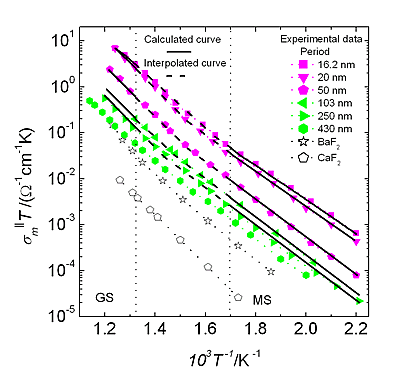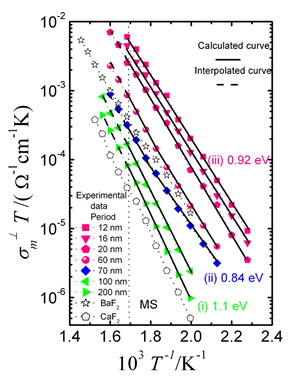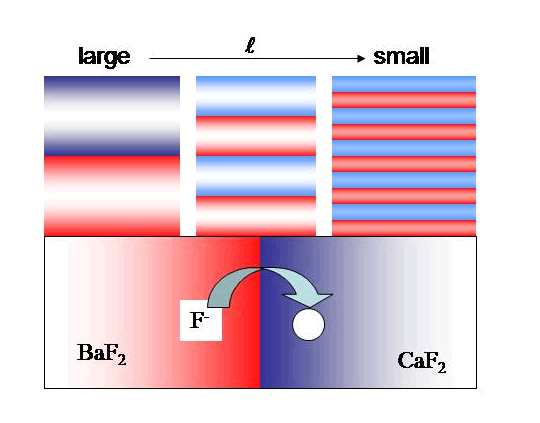Comprehensive modeling of ion conduction of nanosized CaF2/BaF2 multilayer heterostructures
Molecular beam epitaxy-grown CaF2/BaF2 heterolayers are a demonstration of the potential of nanoionics. It has been shown that ion conductivities both parallel and perpendicular to the interfaces increase with decreasing interfacial spacing. This size effect was attributed to the thermodynamically necessary redistribution of the mobile fluoride ions (N. Sata et al., Nature 2000, 408, 946; X.X. Guo et al., Appl. Phys. Lett. 2007, 91, 103102). On this basis, the striking phenomenon of an upward bending in the effective parallel conductivity as a function of inverse interfacial spacing  for low temperatures (T≤593 K) has been satisfactorily explained by application of a modified Mott-Schottky model for BaF2 (X.X. Guo et al., Phys. Rev. B 2007, 76, 125429). This model was further confirmed by measurements perpendicular to the interfaces that offer complementary information on the more resistive parts. Here we present a successful comprehensive modeling of parallel and perpendicular conductivities for the whole parameter range, namely for interfacial spacings ranging from 6 nm to 200 nm and investigated temperatures ranging from 455 K to 833 K. The model is based on literature data for carrier mobilities and Frenkel reaction constants and the assumption of a pronounced
for low temperatures (T≤593 K) has been satisfactorily explained by application of a modified Mott-Schottky model for BaF2 (X.X. Guo et al., Phys. Rev. B 2007, 76, 125429). This model was further confirmed by measurements perpendicular to the interfaces that offer complementary information on the more resistive parts. Here we present a successful comprehensive modeling of parallel and perpendicular conductivities for the whole parameter range, namely for interfacial spacings ranging from 6 nm to 200 nm and investigated temperatures ranging from 455 K to 833 K. The model is based on literature data for carrier mobilities and Frenkel reaction constants and the assumption of a pronounced  redistribution. Taking account of an impurity content that was experimentally supported and apart from minor assumptions concerning profile homogeneity, the only fit parameter is the space charge potential. In particular, it is worth mentioning that in BaF2 the low temperature Mott-Schottky space charge zone which is determined by impurities changes over, at high temperatures, into a Gouy-Chapman situation owing to increased thermal disorder. (The situation in CaF2 is of Gouy-Chapman type at all temperatures.)
redistribution. Taking account of an impurity content that was experimentally supported and apart from minor assumptions concerning profile homogeneity, the only fit parameter is the space charge potential. In particular, it is worth mentioning that in BaF2 the low temperature Mott-Schottky space charge zone which is determined by impurities changes over, at high temperatures, into a Gouy-Chapman situation owing to increased thermal disorder. (The situation in CaF2 is of Gouy-Chapman type at all temperatures.)
This work has recently been done by Dr. Xiangxin Guo currently working as an associated professor in the Shanghai Institute of Ceramics (Chinese Academy of Sciences) and Prof. Dr. Joachim Maier in Max-Planck-Institut for Solid State Research, and published in Adv. Funct. Mater. 19, 96-101, 2009.

Figure 1. Parallel conductivity as a function of inverse interfacial spacing (as published by N.Sata et al. on Nature 408, 946, 2000). The linear and non-linear regions can be clearly identified.

Figure 2. Parallel conductivity of the heterolayers with various periods. The different colours refer to different size regimes. The fitting data in the MS (Mott-Schottky, T≤593 K) and GC (Gouy-Chapman, T ≥773 K) regimes are quantitatively calculated. Those in the intermediate regime (593 K < T < 773 K) are interpolated from the calculated data.

Figure 3. Perpendicular ionic conductivities of the heterolayers with various periods. The different colors refer to different size regimes (for details see X.X. Guo et al., Appl. Phys. Lett. 2007, 91, 103102).

Figure 4. Schematic representation of the conduction mechanism of  transfer from BaF2 to CaF2 and the carrier concentrations in the space charge zones as a function of individual layer thickness.
transfer from BaF2 to CaF2 and the carrier concentrations in the space charge zones as a function of individual layer thickness.



